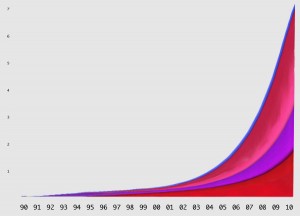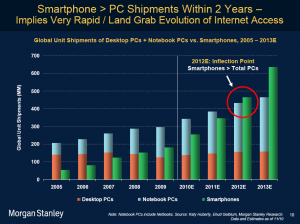What’s happening in the world that defines the wider context for news ecosystems?  What do we know about how the world is moving and where it’s going that can create some clarity on a more tangible level.
The more obvious techtonic shifts affecting us all across the market include things like:
- The increasing numbers of people going online globally
- Increasingly easy and more powerful software tools for creation and ongoing industry standards battles
- The changing distribution methods, including increasingly influential nodes in the network or “points of controlâ€
- Tighter relationships between the network and real world things and vice versa
- Cashflow paths moving online, new streams of revenue and old streams reinvented
- Human behaviors, new norms, real cultural shifts
- New regulation, industry decision-making and the long view of rules
The people, companies, technologies, economics and social issues are going through massive change. Â The intensity across the space is incredible, in some cases expressed through exponential growth curves.
The proven models for success online tend to embrace the whole network as the medium.  The global network itself is the distribution platform.  The network is the market, the medium, the space in which we’re doing our jobs every day.
Why does the network-as-marketplace matter? Â Here are a few reasons that publishers must consider:
First, competing on audience is very hard.
As a news business, we are simultaneously competing on a finite number of newsstands against a limited number of newspaper publishers in one kind of market and a completely different digital market where everyone in the world has equally easy access to every other news publisher in the world.  The Guardian is doing very well on that shelf space.  guardian.co.uk served more than 40M users in November 2010.  But that’s a fraction of what many on this same shelf space are achieving.
ComScore reported that the Top 5 “Properties†in the US each had well over 100M unique visitors in November 2010, all of the top 50 well over 20M.  That’s just their US traffic.  Most of them have strong international audiences, too, inflating those numbers even higher.
Even more dramatic are the numbers powering the ad networks. Â ComScore reported that the Top 50 Ad Networks all reached well over 100M uniques in November 2010.
Distributed platforms are winning the pursuit for eyeballs with and without the help of big ‘properties’.
That’s not to say that such a pursuit is fruitless.
I can’t seem to find any current numbers on total Internet population, but as of December 2008, comScore was reporting that the total number of people online in the world had reached 1 billion.
One billion!  Wow, that’s a lot.
Yet, it’s not.  That means only 15% of all people are using the Internet.  Any ambitious entrepreneur sees big opportunity in numbers like that.
Not everyone sees the opportunity in developing new web sites, though.
Chris Anderson of Wired Magazine posited that the opportunity wasn’t on the web at all, that the web we get via web browsers was in fact dying. Â In his view, the world of apps and devices was changing the shape of the digital media opportunity and that the Web was actually beginning to fail as a platform.
It’s a very thought-provoking hypothesis.
The Internet didn’t like Anderson’s idea, and the opposing arguments appeared instantly.
It turns out that Anderson’s premise was built on bad data.
Sure, the activity on the web has been shrinking as a percentage of all activity on the Internet.
But all activity on the Internet has been growing exponentially, including all the web-based activity. Â The growth rate of video and P2P activity has been mindblowing over the last 2-3 years, but so has activity on the web.

The growth is so astounding, actually, that it’s worth considering some hard questions:
- What exactly have we changed in the last 2-3 years to be a part of that growth?
- What’s different about what we do today compared to 2-3 years ago?
- Are we part of that growth, or are we merely benefitting from the normal usage curve that results from more people joining the network?
Leading indicators
Going back up to the list of techtonic shifts, the number of people online is clearly affecting this growth. Â The software for publishing is getting better and more accessible. Â Blogging and messaging platforms, CMS tools, network-based social products, and photo and video sharing sites are bringing creation to the masses.
Google’s search index boasted over 1 trillion documents way back in 2008.  Twitter, Facebook and new players like Tumblr have all seen exponential growth curves, too.
It’s not just the big dotcom media space that’s popping.  Mary Meeker’s wonderful Web 2.0 Summit slides show the dramatic increase in smart phone shipments and the possibility of those shipments eclipsing PCs in the next 2 years.
If that weren’t enough, the money is really flowing, too.
E-commerce sales will represent 8 percent of all retail sales in the U.S. by 2014, growing to $250 billion, according to Forrester. Â For example, GroupOn, which seemingly came out of nowhere, now earns $800 million, according to several sources, and it’s growing toward $2 billion.
Are we in the middle of a perfect storm? Â What does it mean?
This series is an attempt to assemble some ideas I’ve been exploring for a while. Â Most of it is new, and some of it is from previous blog posts and recent-ish presentations. I’ve split the document up into a series of posts on the blog here, but it can also be downloaded in full as a PDF or viewed as a sort of ebook via Scribd:

